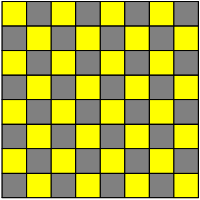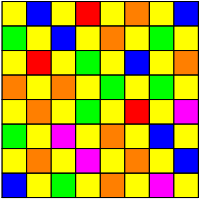Hysteria
This activity belongs to the GeoGebra book Lights Out (Games with solutions).
Try to color the entire board. Each time you click on a cell, it will change its color to one of six, chosen at random.
The madness, the hysteria, resides in the fact that if this new color coincides with the one of a neighboring square... the square pressed and all the neighboring ones will turn off! This can be especially infuriating when you've managed to almost completely color the board...
It's a matter of luck! Notice that the probability of "being unlucky" varies depending on the number of neighboring cells already colored. If we were guaranteed that no pair of neighboring cells could have the same color, the probability of bad luck would be very easy to calculate:
0 cells: probability of bad luck = 0/6 = 0
1 cell: probability of bad luck = 1/6
2 cells: probability of bad luck = 2/6 = 1/3
3 cells: probability of bad luck = 3/6 = 1/2
4 cells: probability of bad luck = 4/6 = 2/3
But since there can be neighboring cells with the same color, that probability decreases:
0 cells: probability of bad luck = 0/6 = 0
1 cell: probability of bad luck = 1/6
2 cells: probability of bad luck = 11/36 (approximately 0.31)
3 cells: probability of bad luck = 91/216 (approximately 0.42)
4 cells: probability of bad luck = 641/1296 (approximately 0.49)
So the more neighboring cells are already colored, the more likely it is that they will turn off when trying to color the chosen cell, although in any case it is always more likely to get colored than not.
If you are using a computer and find that the application responds slowly, you can download it here to increase speed.
A possible strategy could be to first cover half the board with the same color, as if it were a checkerboard:

Thus, the probability that each cell that remains to be colored will turn off the neighboring cells will always be 1/6. From there, each time this happens, we proceed to rebuild "the damage caused" on the checkerboard before continuing until we color the entire board:

Author of the construction of GeoGebra: Rafael Losada